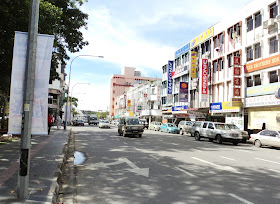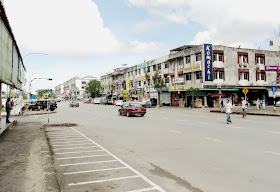
Thursday, December 30, 2010
Bintulu town squatters area - 1984

Monday, December 27, 2010
M O to Roundabout 1 - early 1980's
 In the early 1980's the Public Works Department initiated a dual-carriageway road to connect Bintulu town to its newly opened sub-urban towns ( satellite towns ) especially the Kidurong township and the heavy industrialised zone of Kidurong, some 24 kilometers away from the Bintulu town . The funds were available through Federal funding. The start of the Federal road from Bintulu town was popularly called M O ( Mile zero). This view above shows the road from M O leading out of town towards the first roundabout which is today turned into a traffic lights junction. On the left of the picture is shown white railings that are placed on both sides of the wooden bridge that lead to the small Bintulu hospital then. In the picture a car takes a turn at the road junction to enter the Bintulu hospital area. On the right, the BDA-Shahida commercial center is under construction. In the early years of 1980's the local authority have just started to implement roadside planting. The above shows a brave attempt despite the lack of planting materials. But what was evident was the spirit of cooperation and togetherness between government departments there. The local authority proceeded to undertake the roadside tree planting using its own funds and this also covered its maintenance. The spirit was to make Bintulu a welcoming and beautiful town and it did not matter whether the PWD got the funds or not. The local authority was willing to chip in.
In the early 1980's the Public Works Department initiated a dual-carriageway road to connect Bintulu town to its newly opened sub-urban towns ( satellite towns ) especially the Kidurong township and the heavy industrialised zone of Kidurong, some 24 kilometers away from the Bintulu town . The funds were available through Federal funding. The start of the Federal road from Bintulu town was popularly called M O ( Mile zero). This view above shows the road from M O leading out of town towards the first roundabout which is today turned into a traffic lights junction. On the left of the picture is shown white railings that are placed on both sides of the wooden bridge that lead to the small Bintulu hospital then. In the picture a car takes a turn at the road junction to enter the Bintulu hospital area. On the right, the BDA-Shahida commercial center is under construction. In the early years of 1980's the local authority have just started to implement roadside planting. The above shows a brave attempt despite the lack of planting materials. But what was evident was the spirit of cooperation and togetherness between government departments there. The local authority proceeded to undertake the roadside tree planting using its own funds and this also covered its maintenance. The spirit was to make Bintulu a welcoming and beautiful town and it did not matter whether the PWD got the funds or not. The local authority was willing to chip in. Tuesday, December 14, 2010
Sky Theatre - 1950's
Saturday, December 11, 2010
Bintulu roads ( Part 2)
Today, at the far end of the picture the former roundabout has become a traffic light junction. The dual- carriageway from the traffic junction to the Mosque junction has been altered to become a three-lane carriage way and the Mosque junction fitted with traffic lights thus making the central median narrower. Obviously the number of cars have more than quadrupled over the years. The trees have also over-topped the electrical posts. Today Bintulu is in the fourth boom era and the momentum that has developed over three decades of growth has made it able to ride the fourth boom with greater preparedness and gear itself to become an industrialised city by 2020. However, by all practical purposes it is now already an industrialised town but not given any city status just yet.
Monday, December 6, 2010
Bintulu town - early 1970's
Saturday, December 4, 2010
Bintulu town -1975
Monday, November 29, 2010
OKMS School - 1970's
A concrete double -storey building has taken up space from the original wooden structure site. This school remains the only school situated within the Bintulu town commercial area. From what was once a school serving the local Malay and Melanau community who lived in villages around the school area, today this school accomodates students from various ethnic groups especially the Ibans who have over the years taken up employment in the shophouses and other commercial outfits owned by the Chinese business community located in the Bintulu town area.
Saturday, November 27, 2010
Roundabout 2 traffic island planting - 1980's
Thursday, November 25, 2010
Mile O - early 1980's
Tuesday, November 23, 2010
Jalan Keppel - mid 70's
What was once a tiny two-way street has today become a one- way three-lane town road. The two-storey building on the right was once BDC adminstrative office turned into the BDA Library when Bintulu District Council(BDC) was merged with the BDA ( Bintulu Development Authority) upon the introduction of BDA to administer and develop Bintulu starting the early 1980's. The low building after the ex-BDA library is the Sarawak state information centre which still exists even at this point of blogging. The tall structure after the information centre is the 'Kintown Inn'- a modern touch to the townscape. The open space to the right of the top picture was a community open space that catered for a basketball court and public amenities like swing, see-saw and a resting shed. Today at the same space is allocated a green area with its focal point a public fountain- the first ever for Bintulu and running. Typical of Bintulu shophouses in the 1960's and 1970's they were principally of wooden structures. Today concrete shophouses have replaced the old wooden ones. Note the trend to replace overhead electricity cables with undeground cabling and better tiled street pavements for a modern image town.
Note our fashion during those times. Men wear bell-bottoms, sport long hair and dress smartly as teachers. On the extreme left is yours truly . Others from left to right are Zahiruddin Khan, Angela Chung, Zarina Sauni, Josmani, Wong Kee and Chong Tong Liap. We were all teachers from the Bintulu Government Secondary School (BGSS).
Sunday, November 21, 2010
Bintulu town riverside squatters operation - 1987
The new concrete shophouses around the temple has provided a facelift to the town making it look more modern.
Saturday, November 20, 2010
Bintulu roads (Part 1)

The top picture was taken circa early 1960's. I took another picture of the same location yesterday, 19th November,2010. What was once an earth road made for bicycles and trishaws is now a bituminous paved road. To the left of the top picture is a rubber garden . What is amazing in the picture is the staying power of the tall palm trees and the kampung houses in the far background to the right that are still standing to this date. Many of the people in the picture can be named or recognised if you are a Bintuluian. Only three so far have left us. I am the little boy on the extreme right front row. The picture was taken while attending the marriage ceremony of my uncle who worked with the Public Works Department in Bintulu as a 'caterpillar' or bulldozer driver back then.
Thursday, November 18, 2010
Initial notes
This blog will supplement the other blogs I created on the Bintulu themes ( my bintulu history, my bintulu clicks, Bintulu perspectives) for the expressed purpose of articulating ideas for my proposed " A History of Bintulu " book project.






















